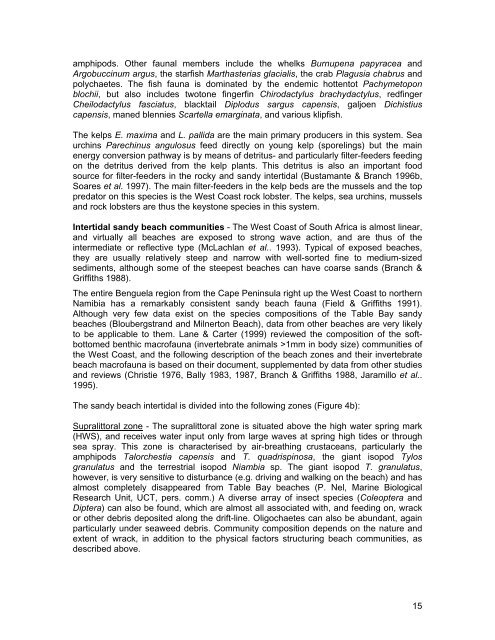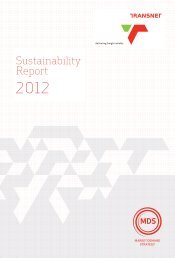BEN SCHOEMAN DOCK BERTH DEEPENING Specialist ... - Transnet
BEN SCHOEMAN DOCK BERTH DEEPENING Specialist ... - Transnet
BEN SCHOEMAN DOCK BERTH DEEPENING Specialist ... - Transnet
You also want an ePaper? Increase the reach of your titles
YUMPU automatically turns print PDFs into web optimized ePapers that Google loves.
amphipods. Other faunal members include the whelks Burnupena papyracea and<br />
Argobuccinum argus, the starfish Marthasterias glacialis, the crab Plagusia chabrus and<br />
polychaetes. The fish fauna is dominated by the endemic hottentot Pachymetopon<br />
blochii, but also includes twotone fingerfin Chirodactylus brachydactylus, redfinger<br />
Cheilodactylus fasciatus, blacktail Diplodus sargus capensis, galjoen Dichistius<br />
capensis, maned blennies Scartella emarginata, and various klipfish.<br />
The kelps E. maxima and L. pallida are the main primary producers in this system. Sea<br />
urchins Parechinus angulosus feed directly on young kelp (sporelings) but the main<br />
energy conversion pathway is by means of detritus- and particularly filter-feeders feeding<br />
on the detritus derived from the kelp plants. This detritus is also an important food<br />
source for filter-feeders in the rocky and sandy intertidal (Bustamante & Branch 1996b,<br />
Soares et al. 1997). The main filter-feeders in the kelp beds are the mussels and the top<br />
predator on this species is the West Coast rock lobster. The kelps, sea urchins, mussels<br />
and rock lobsters are thus the keystone species in this system.<br />
Intertidal sandy beach communities - The West Coast of South Africa is almost linear,<br />
and virtually all beaches are exposed to strong wave action, and are thus of the<br />
intermediate or reflective type (McLachlan et al.. 1993). Typical of exposed beaches,<br />
they are usually relatively steep and narrow with well-sorted fine to medium-sized<br />
sediments, although some of the steepest beaches can have coarse sands (Branch &<br />
Griffiths 1988).<br />
The entire Benguela region from the Cape Peninsula right up the West Coast to northern<br />
Namibia has a remarkably consistent sandy beach fauna (Field & Griffiths 1991).<br />
Although very few data exist on the species compositions of the Table Bay sandy<br />
beaches (Bloubergstrand and Milnerton Beach), data from other beaches are very likely<br />
to be applicable to them. Lane & Carter (1999) reviewed the composition of the softbottomed<br />
benthic macrofauna (invertebrate animals >1mm in body size) communities of<br />
the West Coast, and the following description of the beach zones and their invertebrate<br />
beach macrofauna is based on their document, supplemented by data from other studies<br />
and reviews (Christie 1976, Bally 1983, 1987, Branch & Griffiths 1988, Jaramillo et al..<br />
1995).<br />
The sandy beach intertidal is divided into the following zones (Figure 4b):<br />
Supralittoral zone - The supralittoral zone is situated above the high water spring mark<br />
(HWS), and receives water input only from large waves at spring high tides or through<br />
sea spray. This zone is characterised by air-breathing crustaceans, particularly the<br />
amphipods Talorchestia capensis and T. quadrispinosa, the giant isopod Tylos<br />
granulatus and the terrestrial isopod Niambia sp. The giant isopod T. granulatus,<br />
however, is very sensitive to disturbance (e.g. driving and walking on the beach) and has<br />
almost completely disappeared from Table Bay beaches (P. Nel, Marine Biological<br />
Research Unit, UCT, pers. comm.) A diverse array of insect species (Coleoptera and<br />
Diptera) can also be found, which are almost all associated with, and feeding on, wrack<br />
or other debris deposited along the drift-line. Oligochaetes can also be abundant, again<br />
particularly under seaweed debris. Community composition depends on the nature and<br />
extent of wrack, in addition to the physical factors structuring beach communities, as<br />
described above.<br />
15

















